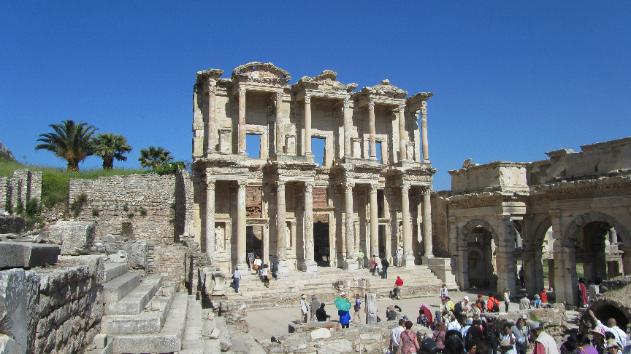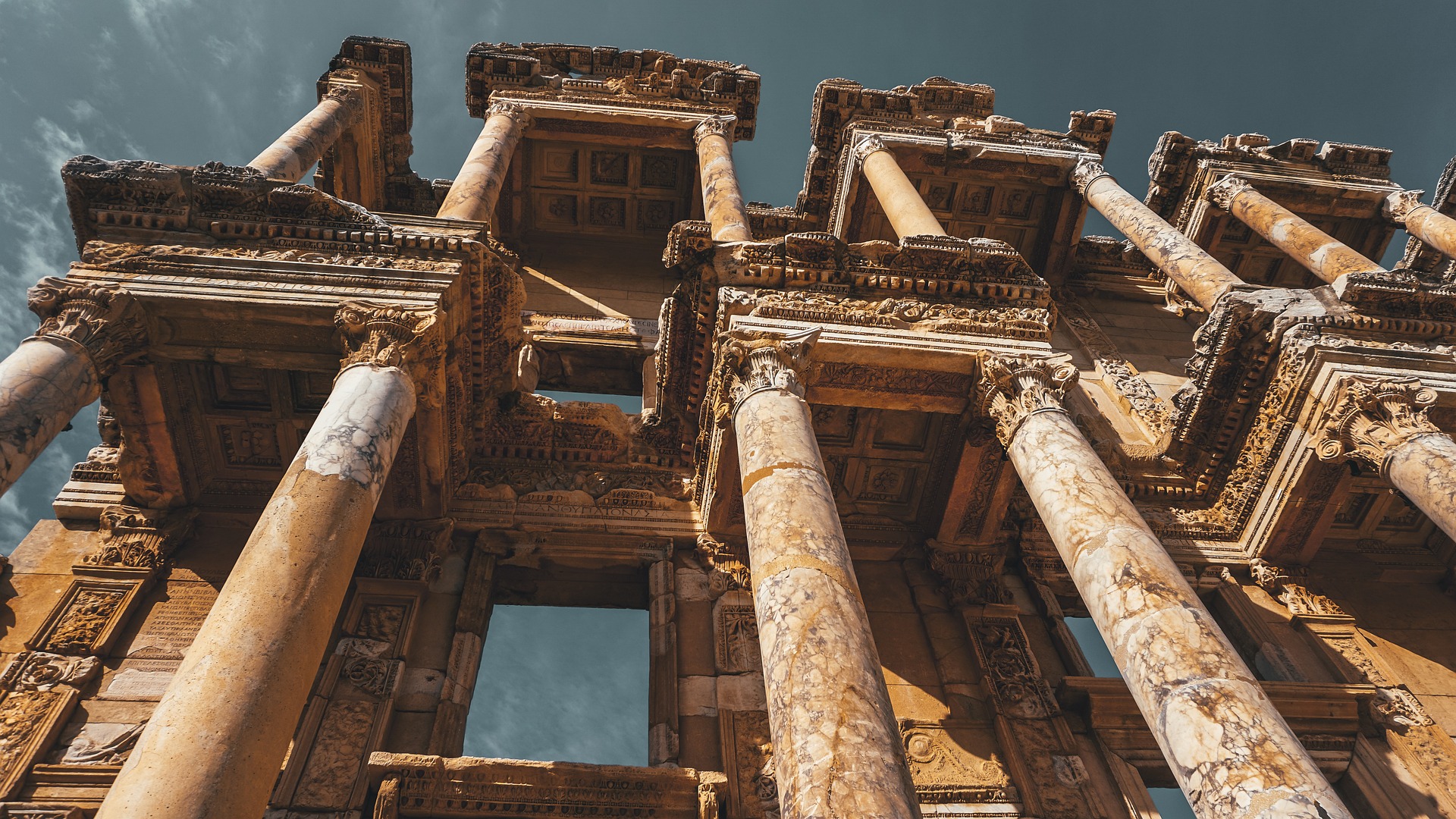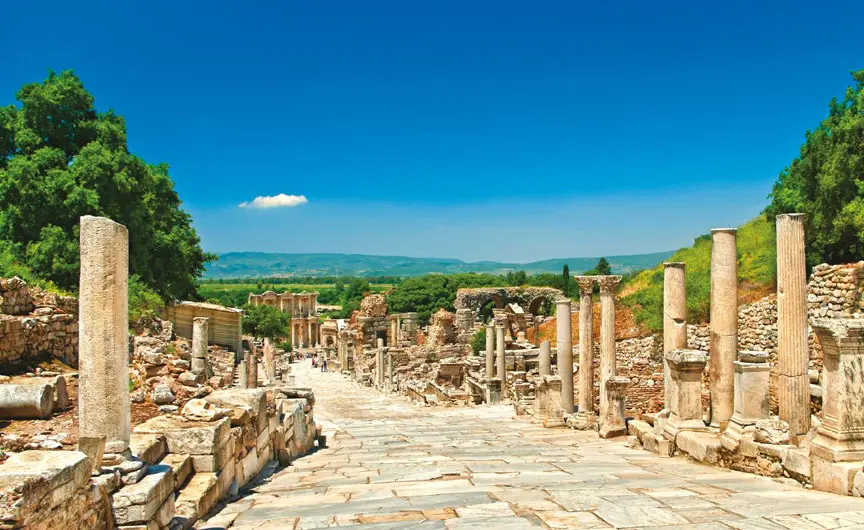Ephesus: Walk Where Gods & Gladiators Roamed

If you're looking for a destination rich in history and culture, Ephesus in Turkey is a must-visit. As a visitor, you'll be taken on a journey through time, discovering the ruins of one of the most significant cities of the ancient world. This blog post will guide you through discovering Ephesus's rich history and provide tips for a successful visit.
Discovering Ephesus and its rich history
Ephesus is a city that dates back to the Neolithic age and is home to the Temple of Artemis, one of the Seven Wonders of the Ancient World. The city grew into a thriving religious and commercial hub, with the Library of Celsus and the Grand Theater two of its most impressive landmarks.
When visiting Ephesus, it's recommended that you start at the Ancient City, where you'll find the Gate of Magnesia and the Odeon. From there, move along to the Temple of Hadrian and the impressive Library of Celsus before finally reaching the Grand Theater. It's an experience that'll leave you in awe of the ancient architecture and wonder about life in the ancient world.
Tips for visiting Ephesus
Visiting Ephesus can be a challenging experience, so here are some tips to ensure a stress-free trip:
- Wear comfortable shoes as there's a lot of walking involved.
- Visit early in the day or late in the afternoon to avoid the crowds and the heat.
- Bring a hat and sunscreen as there isn't much shade around the ruins.
- Take water with you, as there are limited water fountains available.
- If you're an archaeology enthusiast, consider hiring a guide to walk you through the ruins.
Ephesus is a destination filled with ancient wonders and rich history. As a visitor, taking the time to explore the ruins will be a rewarding and unforgettable experience. Just make sure to come prepared with comfortable shoes, protection from the sun, and plenty of water to drink.

Ephesus City of Ancient Times
If you're looking for a destination rich in history and culture, Ephesus in Turkey is a must-visit. As you walk through its ancient ruins, you'll be taken on a journey through time, discovering the remains of one of the most significant cities of the ancient world. This blog post will guide you through discovering Ephesus's rich history and provide tips for a successful visit.
Ephesus City history and significance
Ephesus is a city that dates back to the Neolithic age and is home to the Temple of Artemis, one of the Seven Wonders of the Ancient World. The city grew into a thriving religious and commercial hub, with the Library of Celsus and the Grand Theater two of its most impressive landmarks. It's truly a place where history comes to life, and you can't help but feel amazed at the engineering feats accomplished so long ago. The city has a fascinating legacy, and walking through its streets will leave you feeling humbled and awed at the same time.
Walk through Ephesus City
When you visit Ephesus, it's recommended that you start at the Ancient City, where you'll find the Gate of Magnesia and the Odeon. From there, move along to the Temple of Hadrian and the impressive Library of Celsus before finally reaching the Grand Theater. You’ll be impressed by the grandeur of the buildings and structures and by the attention to detail in every corner. Take your time, and explore the city as much as possible, as you never know what hidden gems you might discover.
To ensure a stress-free trip to Ephesus, wear comfortable shoes, visit early in the day or late in the afternoon to avoid the crowds and the heat, and bring a hat and sunscreen as there isn't much shade around the ruins. Finally, take water with you, as limited water fountains are available. If you're passionate about history, hiring a guide to walk you through the ruins would be a bonus.

The Temple of Artemis
If you plan to visit Ephesus in Turkey, include the Temple of Artemis on your itinerary. This ancient temple is one of the Seven Wonders of the Ancient World and is an incredible example of the architecture and engineering of the time.
The Temple of Artemis history and architecture
The Temple of Artemis was built around 550 BCE in dedication to the Greek goddess Artemis. It was an impressive structure that consisted of 127 columns that reached a height of 60 feet. The temple's architecture blended Greek and Eastern styles, making it unique and a marvel for its time. Unfortunately, the temple was destroyed and rebuilt several times over the centuries, and today, only a few columns remain to give an idea of its grandeur.
Exploring the Temple of Artemis
When you visit the Temple of Artemis ruins today, you can see the remains of the massive columns and scattered carved stones that were once part of the temple. The site also has a small museum with artefacts and models showcasing the temple's history.
Take your time to explore the site and learn about the significance of this ancient temple. Wear comfortable shoes, bring water, and a hat, as the area lacks shade. Hiring a guide would be a great idea as you can learn about the temple's history and the artefacts in the area.
Ensure you visit early in the day or late in the afternoon to avoid the crowds and the heat. Take some time to appreciate the temple's beauty and its significance in ancient times.

The Library of Celsus in Ephesus
If you plan to visit Ephesus in Turkey, you can't miss the Library of Celsus. This ancient structure is one of the most well-preserved buildings in Ephesus and is a beautiful example of Roman architectural design.
The Library of Celsus history and architecture
The Library of Celsus was built in the second century AD by the Roman consul, Gaius Julius Aquila, in honour of his father, Celsus Polemaeanus. The library was a grand structure that stood two stories tall and was adorned with statues and artwork. The library's facade was decorated with intricate carvings and columns, which added to its grandeur.
Exploring the Library of Celsus
Today, when you visit the Library of Celsus, you can see the impressive facade of the building, which has been partially reconstructed. The intricate carvings and columns have all been restored, making for an awe-inspiring sight. You can also visit the small museum on the site, which houses artefacts and relics discovered during the excavation of the structure.
Make sure to explore this ancient structure and marvel at its grandeur. Bring comfortable walking shoes, water, and a hat, as the area can get quite hot in summer. Hiring a guide is also a good idea as they can provide insight into the library's history and the artefacts on display.
The Library of Celsus is one of the most popular destinations in Ephesus, so it's best to visit early in the day or late in the afternoon to avoid the crowds. Take some time to appreciate the beauty of this Roman architectural masterpiece's beauty and its historical significance.

The Grand Theater in Ephesus
This impressive ancient structure is a must-see for lovers of Roman history and architecture.
The Grand Theater's history and architecture
The Grand Theater was constructed in the Hellenistic period, around 300 BC, and was later expanded upon by the Romans in the 1st century AD. It could seat over 25,000 people and was used for various events such as plays, musical performances, and gladiatorial games.
The theatre was designed with a semi-circular seating arrangement, with the stage at the bottom, and had impressive arches and columns that still stand today. The theatre's embellishments were decorated with intricate carvings and sculptures, making it an impressive sight.
Exploring the Grand Theater
Visitors today can explore the theatre and view the impressive architecture firsthand. Walking up the stadium-style seating provides incredible views of the structure and the surrounding area. If you want to understand the theatre's size, stand in the centre of the stage and look up at the towering seats.
There are plenty of photo opportunities throughout the theatre, so bring a camera and comfortable shoes for walking around. Guides are available to help explain the history and significance of the structure, or you can rent an audio guide to learn more on your own.
Visiting the Grand Theater is a highlight of any trip to Ephesus. Plan your visit early in the day or later in the afternoon to avoid the crowds. Don't miss out on this incredible Roman marvel!

The House of the Virgin Mary
If you're visiting Ephesus, the House of the Virgin Mary is a must-see destination. The holy home is an essential pilgrimage site in Turkey for many Catholics, Orthodox Christians, and Muslims.
The House of the Virgin Mary's history and architecture
Legend suggests that the Virgin Mary lived in this small house after the death of Jesus Christ. Archaeologists and historians believe the house was probably built in the 4th century AD. It's a small stone house located on a hillside amid pine trees.
Exploring the House of the Virgin Mary
You can explore the house and see where the Virgin Mary spent her last years. Visitors often describe feeling a sense of peace and spirituality as they enter the house. The interior of the building is decorated with religious artwork and icons, offering a glimpse into the religious beliefs of the time.
The site also includes a sacred wishing wall where visitors can place their desires and intentions. You can light a candle or leave a written prayer to honour the Virgin Mary. Near the house, there is a holy spring believed to have healing powers, where visitors can collect water and take it home.
You can also enjoy the beautiful gardens and views surrounding the house. The place is serene and calming and offers a great escape from the hustle and bustle of the city.
The site provides guided tours, but it's better to come at your own pace and explore it thoroughly. Bring a hat, sunscreen, and plenty of water, as it gets hot and there is limited shade. You can buy souvenirs for yourself or a loved one at the on-site gift shop.
The House of the Virgin Mary is a significant and peaceful place, providing an insight into biblical times, and it's an experience that should not be missed!
The Arcadian Way in Ephesus
If you're in Ephesus, you can't miss the opportunity to stroll down the historic Arcadian Way. The ancient street was once the city's main thoroughfare, and today it remains a fascinating sight for visitors from all over the world.
The Arcadian Way's history and significance
The street is named after the Arcadia province in Greece, which the Greeks originally built in the 5th century BC. Later, the Romans expanded and paved it in the 2nd century AD. The Arcadian Way was once a bustling route that connected the city's commercial area, including the agora, with the famous Library of Celsus.
The Arcadian Way was an important symbol of the power and sophistication of Ephesus. It was where the rich and influential walked, making it an essential destination for merchants, politicians, and philosophers.
Exploring the Arcadian Way
Walking along the Arcadian Way is like stepping back into the ancient times. You can admire the well-preserved marble paving stones, the towering columns, and the grand arches that still line the street today. Visitors often describe feeling the weight of history and the significance of the place as they walk down the same path that many notable figures did before them.
Walking along the Arcadian Way, you'll also pass by several notable sights, including the Temple of Hadrian, the Fountain of Trajan, and the Prytaneion. These ancient treasures offer a glimpse into the glory and magnificence of Ephesus in its prime.
Be sure to wear comfortable shoes and bring a hat and sunscreen, as there is little shade along the way. You can also opt for a guided tour to learn more about the history and significance of the Arcadian Way.
The Arcadian Way is a must-see destination for anyone visiting Ephesus. It's a place that captures the spirit of ancient times and offers a unique insight into the city's past.

The Terrace Houses of Ephesus
If you find yourself in Ephesus, you can't miss the Terrace Houses. You have a unique opportunity to explore the fascinating ancient mansions that once were home to the wealthy and affluent, and today, they offer a glimpse into the past's luxury and grandeur.
The Terrace Houses' history and architecture
The Terrace Houses or "Houses of the Rich" were built during the Roman period around the 1st century A.D. They were occupied until the 7th century and then forgotten until their rediscovery by archaeologists in the 1960s.
The Terrace Houses exemplify ancient Romans' architectural and engineering skills. They feature intricate mosaics, beautifully decorated walls, and exquisite frescoes showcasing the wealth and sophistication of their former residents.
Exploring the Terrace Houses
You can't miss the Terrace Houses during your visit to Ephesus. They are located next to Curetes Street in Ephesus, and entrance fees are included in the admission fee to the archaeological site.
On your visit to the Terrace Houses, you can see the stunning Roman baths with their intricate heating systems, private courtyards, and magnificent frescoes adorning the walls.
You'll be stunned by the level of detail and craftsmanship still in the Terrace Houses today. Don't forget to take your time admiring each room and decoration as you make your way through the complex.
Tips for a memorable visit to Ephesus.
- Wear comfortable shoes, as you'll walk often during your visit.
- Bring a hat, sunscreen, and water, as the weather in Ephesus can get hot during the summer months.
- Consider hiring a tour guide to enhance your experience and learn more about the history and culture of the city.
- Don't forget your camera, as Ephesus is a photographer's paradise.
The Terrace Houses at Ephesus are a must-visit for anyone interested in history, architecture, or design. They offer a unique opportunity to step back in time, experience the opulence of ancient times, and provide insight into the lives of the wealthy and affluent. Follow the tips mentioned above to make the most of your visit, and don't forget to take your time and admire each room and decoration to create lasting memories.
